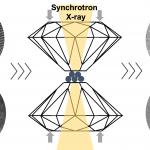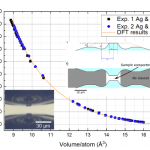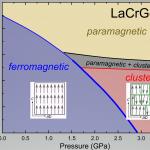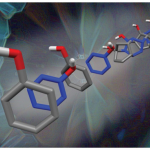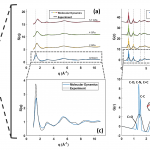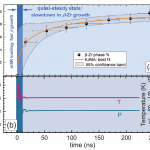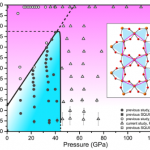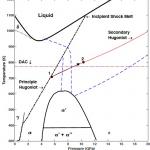Pressure-induced assembly has promising applications for fabrication of nanostructured materials from a wide range of nanocrystals with various size, shape, and composition. Using diamond-anvil compression techniques, combined with small/wide angling x-ray scattering and the x-ray diffraction tools at the Advanced Photon Source under remote operations, the team was able to characterize the structural and morphological changes in PbS and PbSe semiconductor nanocrystals. The experiments performed at HPCAT… more
Silver, a noble metal, is renowned for its purity and chemical stability at standard temperature and pressure. However, theoretical calculations and shock-physics experiments at pressures in excess of 100 GPa (1 million times greater than standard atmospheric pressure) suggest that silver’s ambient-pressure phase become unstable. A collaborative team of experimentalists and theorists from LLNL’s Condensed Matter Physics Section within the Physics Division and High Pressure Collaborative Access Team (HPCAT) at the Advanced Photon Source have revealed that the face-centered-cubic phase… more
The fluctuations associated with quantum-critical points, i.e., second-order phase transitions at zero temperature, have been considered crucial for the stabilization of intriguing phenomena, such as superconductivity or non-Fermi liquid behavior. This motivates the search for novel states by tuning magnetic phase transitions towards 0 K by external parameters, such as physical pressure or chemical substitutions. For clean metallic ferromagnets, it is widely believed that quantum criticality is avoided for generic reasons. It was proposed that the metallic ferromagnet LaCrGe3 is… more
Two recent articles from a team of researchers at Penn State University highlighted the compression of aromatic compounds to make new derivatives of diamond nanothread architectures. Nanothreads are rigid, one-dimensional ordered polymers theorized to possess extraordinary tensile strength, extreme stability over a small diameter, and unique electronic properties inaccessible by sp2-rich carbon material analogues. However, the high pressure for synthesis (often exceeding 23 GPa) prevents wide-scale commercial use. Thus, efforts to reduce the pressure… more
Polymers are becoming increasingly important in defense, medical and aerospace applications, as they have many desirable properties that can be tailored by varying their chemistry. One such polymer, polyurea, is an amorphous block-copolymer with “hard” and “soft” molecular segments that has shown exceptional performance as a coating for blast mitigation, impact resistance, and shock wave attenuation.
A thorough understanding of the atomic and molecular level response of polymers used in defensive coatings under high pressures is key in designing these coatings and formulating… more
One of the unanswered questions in physics is the time dependence of phase diagrams and how to model it. When a material is loaded dynamically through equilibrium phase boundaries, it is the kinetics that determines the real time expression of a phase transition. That in turn can play a significant role in the thermodynamic path that the material takes and its end state.
However, the role that kinetics of phase transitions play in a material’s constitutive properties is not well understood. This lack of understanding is due to a lack of experimental data of… more
Finding new exotic magnetic states arising from geometric frustration is a central focus in condensed matter physics today. One such state, marked by the absence of long-range magnetic ordering in the presence of strong magnetic coupling—even at absolute zero temperature—is the quantum spin liquid. High applied pressures offer several avenues to tune magnetic properties towards new exotic magnetic states. As increasing pressure modifies bond lengths, magnetic coupling interactions can be tuned towards a quantum critical point. Additionally, high pressure can stabilize metastable… more
The ability to understand and predict the response of matter at extreme conditions requires knowledge of a material’s equation-of-state, including the location of phase boundaries, transition kinetics, and the evolution of material strength. Cerium is a material with a complex phase diagram that continues to attract significant scientific interest. A recent publication, Dynamic experiments to study the α−ϵ phase transition in cerium (B. J. Jensen and F. J. Cherne from LANL and N. Velisavljevic, HPCAT/LLNL) J. Appl. Phys. 127, 095901… more

